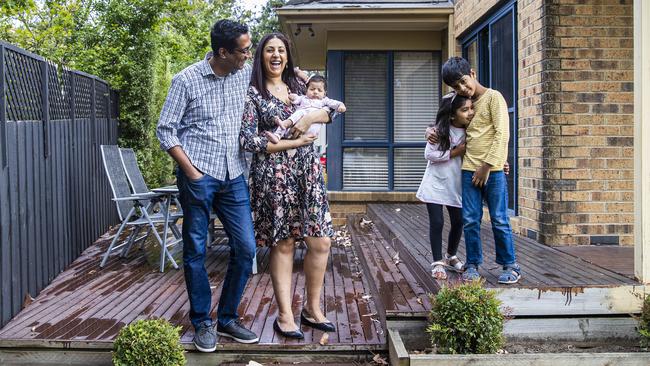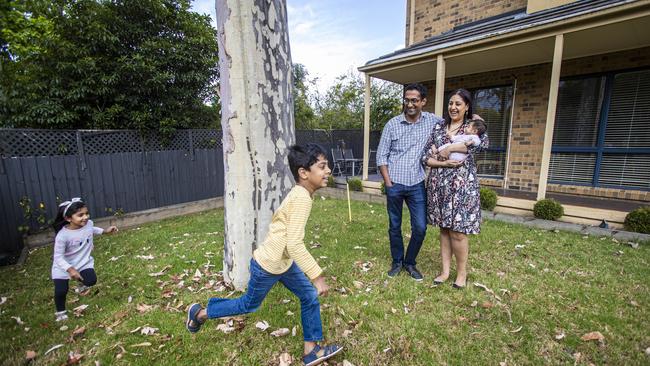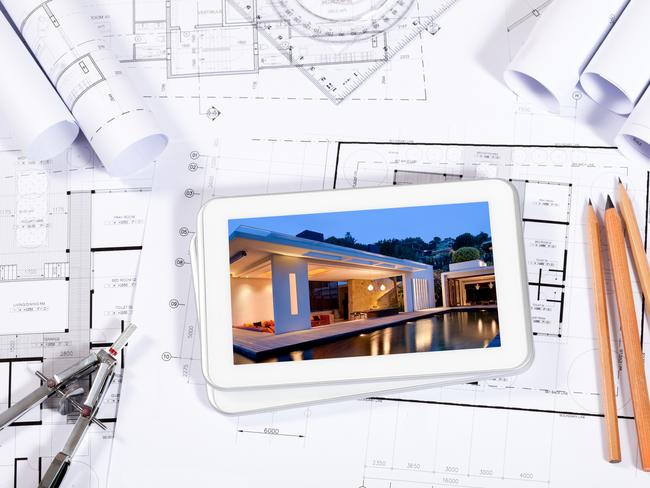Home sweet castle: space and safety all the rage in the lockdown age
The threat of lockdowns has forced us to reappraise the Australian home — and McMansions may be making a comeback.

COVID-19 has forced us to look afresh at how we work, play and live — so it’s no surprise that the Australian home is also being reappraised. And if you think it’s just a matter of turning the spare bedroom into an ersatz office, think again.
Something very profound is happening in our suburbs and apartment blocks — and in our inner-city terraces and urban-fringe subdivisions — to reimagine housing.
A number of the changes predate the pandemic but were supercharged by lockdowns and work-from-home duties performed by an estimated one in three wage earners or small business operators over the past 12 months.
Others suggest we will be living with the legacy of the virus long after it has been tamed by vaccines. And for once, this is no bad thing.
COVID-19 has forced people to turn inward, to spend weeks or even months at a time inside four walls, redefining how we use the home, how we perceive it, and how we pursue our national obsession with buying or selling real estate.
If the under-appreciated quarter-acre block has made a comeback in our affections — the less-used crannies pressed into service as work space, the yard a sanity-preserving sanctuary — then time devoted to a grinding commute through gridlocked traffic never seemed more wasted.
Open-plan layouts don’t seem quite so attractive now that we need to carve out niches in which we can hear our ourselves think or participate in a Zoom session.
As for that fashionably sparse, minimalist urban apartment: the study “nook” goes only so far when both partners are at home wanting to use it. Inner-city chic, we are discovering, isn’t designed for 24/7 use. Whatever its shape or configuration, the post-COVID home needs to do more.

“The pandemic asked a lot of questions of our housing about how capable it was of taking on other roles, and those questions aren’t necessarily going away,” says Chris Tucker, an architect and academic.
“It might be creating areas for one or both partners to work at home, or while home-schooling children. Or areas where people can have private conversations or just somewhere to get away for a bit because everyone is at home.
“City people, in particular, were in a pattern where they got up in the morning and went to work, the children went off to school, and the home was only used intensively for limited periods in the morning and evening.
“All that changed with COVID for a lot of people.”
Developers are taking note. Australians already live in some of the world’s largest homes — averaging 235.8sq m of floor area for new properties, CommSec says, second only to Americans.
Perth builder Cedar Woods tested the market with a “flexispace” option for a townhouse offering in Subiaco, a sought-after inner-city address. Essentially, this adds a room with plumbing and full connectivity atop the garage, ideal for a home office. It sold out.
“If a design doesn’t have a study or multiple spaces that people can do day-to-day work in, then it’s off the shopping list,” says Ricky D’Alesio, design manager of the Metricon group.
“The biggest way home design has been impacted is by the ability to work from home. Before, a home office was never high on the agenda of people looking to buy a home — probably about 10th on the list. But now it’s No 1.”
For Anita and Shankar Krishnan, living cheek by jowl with their three children, including a newborn baby, in their three-bedroom home in Glen Iris in Melbourne’s inner-east was no longer an option. The home they are building boasts sliding partitions to customise shared areas, and the formal living room was converted to an office.
“We wanted those sort of designated areas where, depending on who we’re talking about in the family and what stage of life they’re at, everybody has the opportunity to sort of cut out the noise and retreat for work or study or just downtime,” says Shankar, a 40-year-old business and technology consultant.
Anita, 38, a medical researcher, says they’re all too aware that adults and kids need their own space. “They’ve got a dedicated study and we have a home office downstairs,” she says.
Cedar Woods managing director Nathan Blackburne says the buyer pool has changed accordingly. Record low interest rates backed by state and federal grants offered as pandemic stimulus have brought first-home buyers thundering back into the market, lifting their share to about a third of all property purchases.
Blackburne says there is also “great emphasis” on catering for returned expats, especially from virus-stricken Britain. Many of them lived in flats or apartments under lockdown in London and don’t want to reprise the experience. “Customers are specifically saying to us they have changed their preference towards lower density housing … like a townhome because they are concerned about further lockdowns and they now place much greater value on privacy, their own open space and the superior social distancing,” he tells Inquirer.

Tucker, head of discipline at the University of Newcastle’s School of Architecture and Built Environment, likes the idea of creating two dwellings in one with a secondary house. Traditionally, this is the “granny flat”, a stand-alone structure in the backyard or semi-detached from the main house. But COVID-19, he says, has shown it can be done in another way with the house “subdividing itself” or becoming part of a collection of interconnected dwellings.
Compound living is not as exotic as it sounds. If space allows — and here we return to the appeal of the quarter-acre block of 1000sq m — a young family might start out in the main house of, say, three bedrooms with a fourth employed as a multi-use study or entertainment room. In a new-build, allowance can be made in the development footprint for a secondary house. While the children are young, this could contain detached workspace for the parents; when the kids grow into their teens, it becomes their sleeping, study and recreation quarters while the main house is reclaimed by the adults; later on, the grandparents might move in, freeing up capital to help the youngsters buy property of their own.
But what about inner-city sites, where such space is either unavailable or prohibitively expensive, and most likely both? Tucker points to Japan. There, homes can get down to a tiny 10sq m, not a model he advocates for Australia. But the “better parts of Tokyo” offer compact, two-storey houses with “contact with the ground”.
“Apartment buildings in the COVID situation almost feel like prisons, dare I say, and certainly the quarantine areas are in those kinds of settings,” he says. “My thing is cities are better when they have fewer apartment buildings.”
Establishing a secondary house within the existing structure is not as difficult as you might think. It doesn’t have to involve taking down walls or structural remodelling; a lot can be done with furniture, Tucker says. Bookshelves and cabinets can be on wheels to partition large rooms, featuring built-ins such as desks. A parent might work on one side while headsetted children go at it on their devices on the other side. When entertaining, the room divider can be pushed back to open up the space.
Remember when every home had its “good room” — the formal parlour or lounge where guests were entertained and sticky-fingered kids ventured at their peril? Well, it’s enjoying a revival of sorts. Demographer Bernard Salt says today’s good room is actually the kitchen-family area which has moved upmarket and been put on display with the likes of marble surfaces and expensive goosenecked tapware. This is part of the evolution of the “public-private house”, accelerated by COVID-19.
“There’s a tortoise shell effect,” Salt says. “We want a hard perimeter that protects us from a threatening world. In the post-COVID home, you won’t have a pretty front garden that you show off to the neighbours with a picket fence. You will have a wall and a roller door where you come in; the prettiness is inside … with two houses in one, green zones where visitors come and are showcased, delivering a curated profile as you do on Instagram.
“But real life takes place in the red areas — the ensuite bathrooms, the butler’s pantry behind the show kitchen, the laundry.”
One thing hasn’t changed, though. “Showcasing our prosperity and European-esqe sophistication is really important to Australians,” Salt continues. “Because at the core of it, we are kind of needy for approval and still quite colonial.”
The virtues of “wellness” have migrated from how we live into where we spend time at home. The antifungal grout you had the contractor put in the bathroom tiling now has a companion: specially-treated antibacterial kitchen benchtops. No-touch sensor taps are also gaining in popularity, builders say.
“People have stopped and reflected about … wellness and making their home take on that sense of health,” Metricon’s D’Alesio says. “There’s a real focus on the tactile surfaces … fewer touching surfaces and more smart technology is coming into the home.”
At the macro level, the pandemic will help drive a reset in urban development that planners have been talking about wistfully for decades. The gold standard is the so-called 20-minute city — the idea being you should be able to get to where you need to work, play or shop within 20 minutes of home. Long-suffering commuters in Sydney, Melbourne or Brisbane might wish.
Instead, city-dwelling Australians got the fried-egg model envisaged by Canadian academic Richard Florida, the “rock star of urban regeneration” whose 2002 book The Rise of the Creative Class detailed how the clustering effect of young creatives and tech workers in the rich “yolk” of the inner belt was enhancing economic prosperity. Good news for hipsters, not so much for the suburban and town folk.
Salt, managing director of the Demographics Group and a columnist for this newspaper, says: “That narrative is kind of flawed in the post-COVID world. Density is not good, it doesn’t create frisson. Density creates infection in the minds of people living with COVID in Australia, Europe and America.
“The apartmentia and density-is-good obsession doesn’t play now. Ideally, what you would want is a separate house on a separate block of land, and that plays directly into the heartland of middle Australia. Middle Australia hasn’t moved, but the world has shifted in its favour … the winds are blowing in Darryl Kerrigan’s direction,” he adds, referencing the much-loved lead character in The Castle.
The regions have picked up through tree-change 2.0, as COVID-19 restrictions helped people realise they could as easily work from home in Beaudesert as Brisbane, Bunbury as Perth, or Gosford on the NSW central coast rather than in inner-Sydney without the eye-watering mortgage and infection risk.
New figures from REA Group show that the volume of property sales in Western Australia’s wheat belt increased by a nation-leading 76.2 per cent in 2020, reflecting the exodus from the capitals. This was followed by Bunbury (up 61 per cent), the Queensland outback (up 47.5 per cent) and NSW’s New England and North West regions (41.4 per cent).
Cameron Kusher of REA said annualised growth in residential property prices in regional Australia was 20 per cent in 2020, double the rate for the aggregated big cities market. Counter-intuitively, metropolitan buyers were prepared to pay more for property in the teeth of the economic fallout of the pandemic. Kusher says 35.6 per cent of those searching realestate.com.au in the city were in the $1m-plus home range, compared to 26.9 per cent in 2019. No prize for guessing where the savings from those cancelled overseas holidays and nights on the town went.
Urban planners and state and local authorities will be keen to convert some of the wider benefit of having more people work from home into lasting gain. Extrapolating 2016 Census data, Salt estimates that up to 35 per cent of the urban workforce steered clear of the office or workplace at the height of the emergency last winter, an increase of at least seven-fold on pre-pandemic levels. The key will be how many make the arrangement permanent.
Salt’s best guess is that the figure will come in around 10 per cent at the next Census, due in August. Nicole Gurran, a professor of urban planning at the University of Sydney, says even a modest increase in the stay-at-home workforce would have an outsized effect on easing traffic congestion and overcrowded public transport in the east coast population centres. She is less confident about a reset on Sydney’s sky-high property and rental markets. The problem is not the housing supply — it’s the availability of affordable housing, and the COVID-19 response did little to alter that.
“We are seeing just as many pressures at the bottom end of the market,” Gurran says. “It’s not opening up. For example, we are seeing no change in the number of people searching for shared accommodation on sites like flatmates.com.au.”
Gurran is more encouraged by the boom in secondary house construction, though she points out this was underway in the NSW capital before the arrival of the virus. From her bedroom window in inner-west Sydenham she can spy four newly-added granny flats, and is full of praise for the measures the state government took to speed the approval process and allow owners to rent the auxiliary accommodation to non-family members, banned in other states.
Salt, for his part, loves how his suburb has come to life in Melbourne’s leafy east. It’s good that things have returned to near-normal since the city’s 112 days of level-four lockdown ended last October. But he doesn’t miss the daily commute and will continue to work from home, marvelling at the number of people he can see and meet in the street, out and about exercising or taking a break from the grind, as he does.
“There is an energy to this street which I hadn’t appreciated was there,” he says. “Then it struck me: I’ve never been here before during the weekday. The theory was that once the lockdowns were over … we would all go back to normal, to how we lived our lives before COVID. Well, I don’t buy that. I don’t think the normal we were living was the best option, the best way.
“What is normal about living on the city edge and commuting into the city centre and back out again every weekday for a 35-year career? If … you said to a millennial — someone in their late 20s or 30s — this was going to be their life, they would say there has got to be a better way to organise it.
“And that’s exactly where we are now at. Yes, most workers will probably go back to working and living in much the way they were, but you only need 5 per cent of them to make a different choice and that would have a huge effect on commuting and re-energising suburbia.”

To join the conversation, please log in. Don't have an account? Register
Join the conversation, you are commenting as Logout